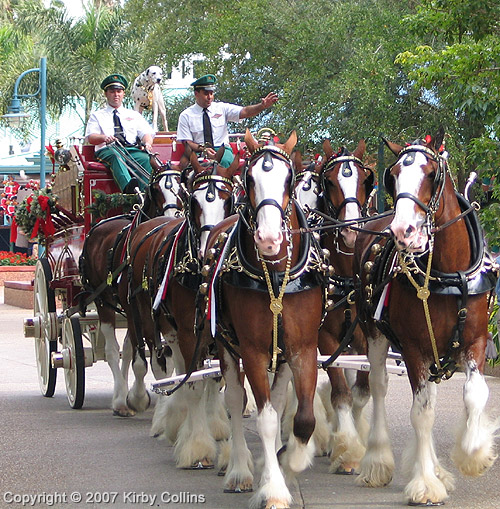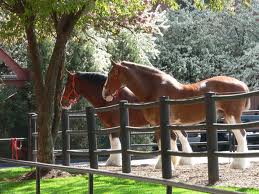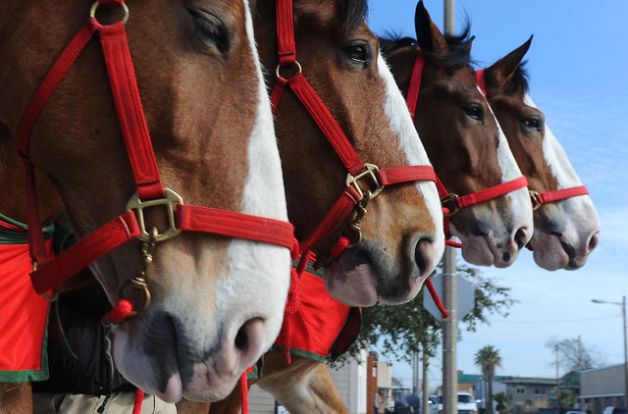Posts tagged Budweiser Clydesdales
Budweiser Clydesdales 2013 Mardi Gras Schedule!!
2Here come the most incredible draft horses in the world, the fabulous Budweiser Clydesdales hitch, six huge Clydesdales at a time, pulling an old time beer distributors truck on St. Charles Avenue and Canal Street.
The Clydesdale is a breed of draught horse derived from the farm horses of Clydesdale, Scotland, and named after that region. Although originally one of the smaller breeds of draught horses, it is now a tall breed. Often bay in colour, they show significant white markings due to the presence of sabino genetics. The breed was originally used for agriculture and haulage, and is still used for draught purposes today. The Budweiser Clydesdales are some of the most famous Clydesdales, and other famous members of the breed are used as drum horses by the British Household Cavalry. They have also been used to create and improve other draught breeds.
01/26: Krewe of Pontchartrain – Drive New Orleans, LA
01/27: Krewe of Alla – Drive New Orleans, LA
01/29: Mardi Gras-Single Horse – Drive New Orleans, LA
01/30: Mardi Gras-Single Horse – Drive New Orleans, LA
02/01: Krewe of Metairie – New Orleans, LA
02/02: Krewe of Olympia – New Orleans, LA
02/06-01/07: Mardi Gras-Single Horse – New Orleans, LA
02/08: Krewe of d’Etat – New Orleans, LA
02/09: Krewe of Endymion – New Orleans, LA
02/10: Krewe of Bacchus – New Orleans, LA
02/12: Krewe of Argus – New Orleans, LA
The breed was developed from Flemish stallions imported to Scotland and crossed with local mares. The first recorded use of the name “Clydesdale” for the breed was in 1826, and by 1830 a system of hiring stallions had begun that resulted in the spread of Clydesdale horses throughout Scotland and into northern England. The first breed registry was formed in 1877. In the late 19th and early 20th centuries, thousands of Clydesdales were exported from Scotland and sent throughout the world, including to Australia and New Zealand, where they became known as “the breed that built Australia”. However, during World War I population numbers began to decline due to increasing mechanization and war conscription. This decline continued, and by the 1970s, the Rare Breeds Survival Trust considered the breed vulnerable to extinction. Population numbers have increased slightly in the intervening time, but they are still thought to be vulnerable.
Budweiser Clydesdales headed to Carnival
1Carnival in New Orleans wouldn’t be the same without the annual appearance of the famed Anheuser-Busch Clydesdale Horses. The eight horse hitch pulling the traditional Budweiser beer wagon will appear in seven parades in the New Orleans area: 2/6, Excalibur (North Shore); 2/7, Mardi Gras; 2/10, Druids; 2/13, Endymion; 2/14, Bacchus; 2/16, Zulu.
The Clydesdale breed is a heavy draught (work) horse breed originating in Scotland and improved through crossbreeding with Flemish stallions. They were introduced into America as a draught horse used to pull a load.
In 1933, August A. Busch, Jr. introduced the first Clydesdale hitch to celebrate the end of Prohibition. Today, three eight-horse hitch teams travel the US, making more than 400 appearances annually.
The Clydesdales travel in style. Each eight-horse hitch is transported via caravan in three fifty by eight-foot custom designed vans with air cushion suspension, thick rubber flooring to ease the rigors of standing. Vent fans and insulation assure fresh air and comfortable temperatures. The caravan stops each 100 miles while traveling and at night to attend to the horses’ comfort.
Weighing in at slightly more than one ton, each gelding eats 25 pounds of pounds of beet pulp, crimped oats, bran, minerals, salt, and molasses daily, plus 55 pounds of hay.
In 1950, the first dalmatian appeared for the Newark Brewery Opening. They have been the official mascot ever since.
Grooming and dressing the Clydesdales is a massive undertaking. It takes an average of 45 minutes to wash a single horse. Braiding ribbons into the mane and tail takes another 20 minutes. Then into the black and brass $35,000 custom-made harness-ware. In all, it takes five hours of strenuous work to ready each animal to meet their public, and they sometimes make two appearances in a day.
In the New Orleans area, the Clydesdales are stabled at the local Budweiser Distributor:
Southern Eagle Sales & Service
5300 Blair Drive
Metairie, LA 70003
They always have a nice display set up and you can come out and pet them and meet the handlers who take care of them and travel with them.



